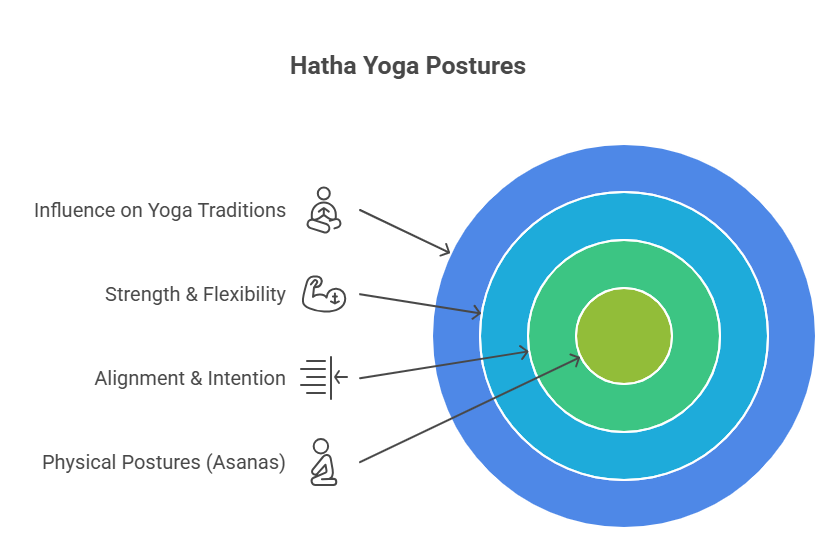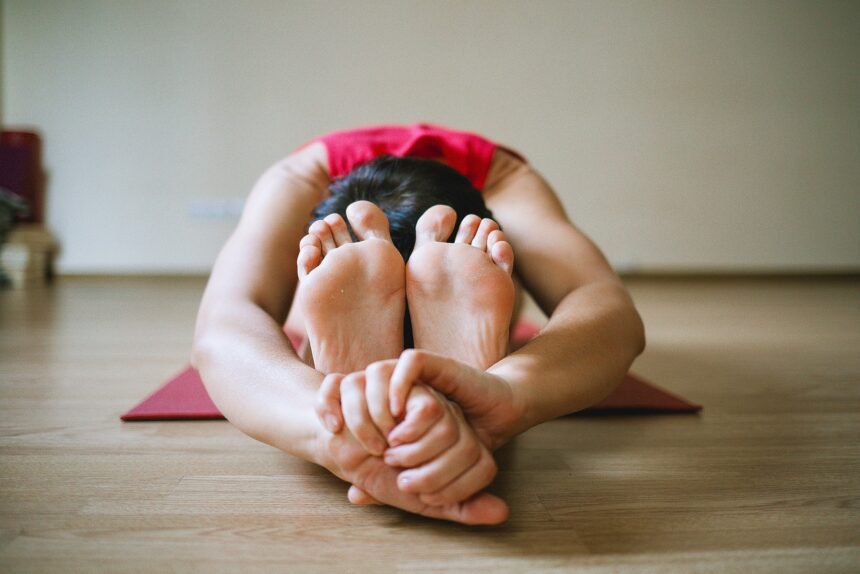Hatha Yoga Introduction Hatha Yoga is one of the simplest and ancient most form of yoga which emphasizes on postures, breath control and meditation. Most of us are well acquainted with Hatha Yoga — the form of yoga that uses physical postures (asanas) and breath control (pranayama) to increase strength, flexibility and balance, while calming our minds.
The slow and relaxed nature of Hatha Yoga sets it apart from other styles, making it an ideal starting point for beginners or those seeking a more meditative practice. Unlike the moving meditation of Vinyasa Or the sweaty aggressiveness of Bikram, Hatha gives you long held poses that allow for longer observation in exactly how your body is aligned.
The philosophy behind this age-old practice is actually revealed in its very name. Hatha literally means in Sanskrit Ha = Sun and THA= Moon, or the balance of opposites within the body. These dual aspects represent the male and female energies, yin/yang, active/passive, strong/flexible that Hatha Yoga aims to balance.
The physical fitness is not the end goal of Hatha Yoga. This integration brings about strength and flexibility of body, support in clarity of mind, emotional balance and spiritual awareness. Hatha Yoga is a complete system for bringing the body back to health, releasing emotional blockages and preparing one for enlightenment which is even attainable in our present lives.
Historical Background
Hatha Yoga has been planted in the soil of ancient history, with some pranayama forms to be born before 1st century. The physical postures we now think of as yoga, however, were a later innovation and not even the main emphasis for those early yogis (meditation and breathing practices came first).
The Classical Hatha Yoga of the 15th century taught a broad practice including asanas (postures), pranayama (breath control) and mudras (hand gestures and energetic seals) involving meditation. During this time many mollifying texts like the Hatha Yoga Pradipika came in to existence, that mentioned about both theoretical and practical aspects of Yoga. In the classical approach, these were simply prerequisites for attaining spiritual enlightenment and self-realization.

The West received its first introduction to yoga in 1893, when Swami Vivekananda (1863–1902) spoke at the Parliament of Religions in Chicago. His dissemination of yogic philosophy helped initiate a stir in the West, but asana would not take off for another several decades.
The modern revolution started in the 1920s with radical yogis blending traditional poses with calisthenics and gymnastics. These new forms of yoga, it can be argued were more dynamic and palatable for our Western nature, but still stemming from the traditional principles of hatha yoga. The modern transmission of Hatha Yoga to the West comes from teachers like Krishnamacharya, B.K.S. Iyengar, and Pattabhi Jois.
Also Read : FamousParenting MomLife: Real Talk, Real Moms, Real Moments
Key Aspects of Hatha Yoga
1. Physical Postures (Asanas)
The visible root of the Hatha Yoga practice is Physical postures. Hatha yoga is very different from the faster paced types of yoga, such as power or Ashtanga where each posture flows into and out of one another. Increased holds give teachers the opportunity to work on alignment, understand a little more of each shape and grow in their practice with intention function, by linking every inhale and exhale to every asana.

There are extensive asanas in Hatha yoga, it include simple seated poses to advanced arm balances, and you will also be able to see some of the deeper backbends as well. Every pose works different muscle groups and awakens overall body perception. By allowing students to slightly adjust, test their limits and progress slowly they will be able to develop the strength & flexibility they need without feeling overwhelmed with challenging poses.
Many of the current yoga practices are based on Hatha Yoga, from Vinyasa and Iyengar to Ashtanga. Mountain Pose, Downward Facing Dog and the Warrior poses are fundamental in Hatha classes (which span across nearly all yoga traditions).
2. Breath Control (Pranayama)
What differentiates yoga from simple stretching or exercise is that yoga is accompanied by conscious breathing linked to movement. There are a lot of different breathing techniques used in pranayama and these can be quite beneficial for calming the nervous system, improving focus as well benefitting health when practiced to time. Breathing is coordinated with movements of the body and a mindfulness (meditation) in motion through sequencing which teaches the mind to be calmer.
Common pranayama techniques begin with deep abdominal breathing known as the three-part breath then we practice alternate nostril breathing. These practices target the autonomic nervous system, decrease stress hormones and increase oxygenation throughout the body.
3. Mindfulness
Being in your body and breath with each pose breeds a being present mindset that goes far beyond the mat. Hatha Yoga teaches observers to watch in on-going physical sensations, emotional reactions and mental patterning without reflecting on them. This consciousness leads to current-moment awareness, insight and internal rest.
The slower pace of Hatha Yoga itself is particularly conducive to mindfulness practice. Instead of only flowing through mouvements, they take time to feel the nuances in their practice and develop greater self-awareness.
4. Accessibility
Hatha yoga is accessible for all ages and fitness levels, and there are modifications available for students working through injuries or difficulties. When taught in a class, teachers generally provide lots of variations for each pose, using props (such as blocks, straps and bolsters) to make the poses accessible to anyone.
The style is a very inclusive one, which means that seniors, those recovering from injuries, and even beginners can benefit from it. Putting the focus on getting in a proper position and working to lower yourself down slowly really helps in preventing injuries, while at the same time building confidence.
Structure of a Typical Hatha Yoga Class
A regular Hatha Yoga class is usually from 45 minutes to 90 minutes long and follows a certain sequence, which aims in a way to get the body-mind complex ready for further practice.
Each class starts with centering and breathing which helps the students to move of out of their daily rhythm into a more present way. This initial phase might consist of some basic pranayama or a short meditation to set the tone and establish intention.
That is because warm-up stretches come next, slowly loosening up muscles and joints for the full expressions of yoga poses. It could be some neck rolls, shoulder shrugs, cat / cow stretches or a few gentle movements of your spine which helps in more blood circulation and flexibility.
The first part consists of a sequence of standing and seated postures put together in order. Warrior I and II, Tree Pose, Triangle Pose in standing poses bring stability and strength. Ow: Seated poses are great for(in general i.e. Forward Folds or Heart openers) but some hip openers add flexibility for introspection.
Classes generally finish with Savasana (some people wonder where the name Corpse pose came from); everyone’s fave way to end, as it gives time for the body to absorb all that goodness it has been given over the practice and lets the brain settle down into meditative bliss. This last relaxation is considered necessary in order for the nervous system to re-balance and the positive effects of the practice to sink into his deep self.
Benefits of Hatha Yoga
Physical Benefits
Hatha Yoga — This is the practice of physical exercise Postures (Asanas), controlled breathing (Pranayama) and relaxation. it offers a complete path to wellnes by ensuring that our skeleton, fascia, muscles, cartilage all together get a chance to revitalise and inturn remain fit for our daily actions. Practice teaches tight muscles to lengthen, weak areas how to strengthen, and daily alignment of movement.
Hatha poses designed to be held develop elasticity, strength and stamina in your muscles. Balancing poses improve proprioception and stability which reduces the risk of falling and helps with athletic performance. The sharpening of alignment goes a long way to righting the postural wrongs perpetrated by sofa-sitters and desk-jockeys, not to mention all those years of doing the same thing over and over again in angry shoes.
Mental Benefits
Reduces stress, improves concentration and induces a state of deep relaxation. The blend of movement and breath with presence activates the parasympathetic nervous system and alleviates chronic stress.
For example, regular Hatha Yoga can decrease cortisol levels, blood pressure and improve sleep patterns. Mediation adds focus, concentration and calms the mind with better emotional control and mental endurance.
Holistic Well-being
And after all, Hatha Yoga produces and nurtures an overall healthy mind-body connection that transcends the physical boundaries into other realms of life too. Practitioners typically claim a higher level of self-awareness and lower stress levels following the practice, with a sense of inner peace.
The self-development and relational value system of Hatha Yoga is based on the philosophy that helps to keep a person’s dignity high, where concepts have been derived as an nonessential – ahimsa (non-violence), satya(truthfulness), santosha(contentment) etc.
Hatha Yoga for Beginners
For the beginner yogi, Hatha Yoga is the best place to start as it moves much slower and will teach you every posture with more importance on the alignment in each pose. It leads beginners along with a slower progression, so they can learn the correct movement essentials breathe comfortably without feeling rushed.
The slow pace of the movements helps for proper alignment and breath — something you can take home from class! Teachers are able to offer individual tweaks and adjustments so students develop proper habits from the outset.
Beginner programs Often with a little more structured start, you will find your way in some classic foundational poses, Sun Salutations and mindfulness orientated stretches to give you the feel of what it is all about. Most of these programs have a progression — you start with easier poses and work your way up to more intense variations, as you get more comfortable and strong.
Most studios offer Hatha classes specifically for beginners or as a series workshops that introduce the philosophy behind yoga, breathing techniques, and breakdown basic poses. Specialized offerings thus establish safe spaces where students can ask questions and their needs are taken into account.
Conclusion
Hatha Yoga is not only a self-contained system but also the fountainhead of most modern styles of yoga. It combines physical postures, breath control, and meditation and contemplation, to be as healthy (in body, mind & spirit) as a complete way of livingHH. Not only the advertised concentration on wellness amounts to little more than opportunistic hype; but traditionally practiced yoga has been tested over time by millions of people in many cultures from East to West with highly valuable proven benefits all around health wellbeing.
Hatha Yoga moves beyond the three when we bring movement, breath and mindfulness together in one practice- allowing for greater flexibility and strength for healthy physical body while reducing stress and increasing focus for a sound mental framework. This integration allows for an equal and balanced emotional body, meant to address the full color spectrum of human form.
Hatha yoga is consider an integrated practice suitable for all levels that offers a life long-sustained practice which can accommodate your ever changing needs. If you’re looking for more fitness, less stress or just a higher level of spiritual wellness, this kind provides you with the skills to become healthier.
Hatha Yoga is beautiful because it is simple and deep. The practice is endless and while the poses may seem simple, there are infinite opportunities within them where you can grow, learn about yourself, change things. When you step onto the mat, you become part of over eight million people worldwide who have discovered in Hatha Yoga a conduit to better balance, serenity and health.


